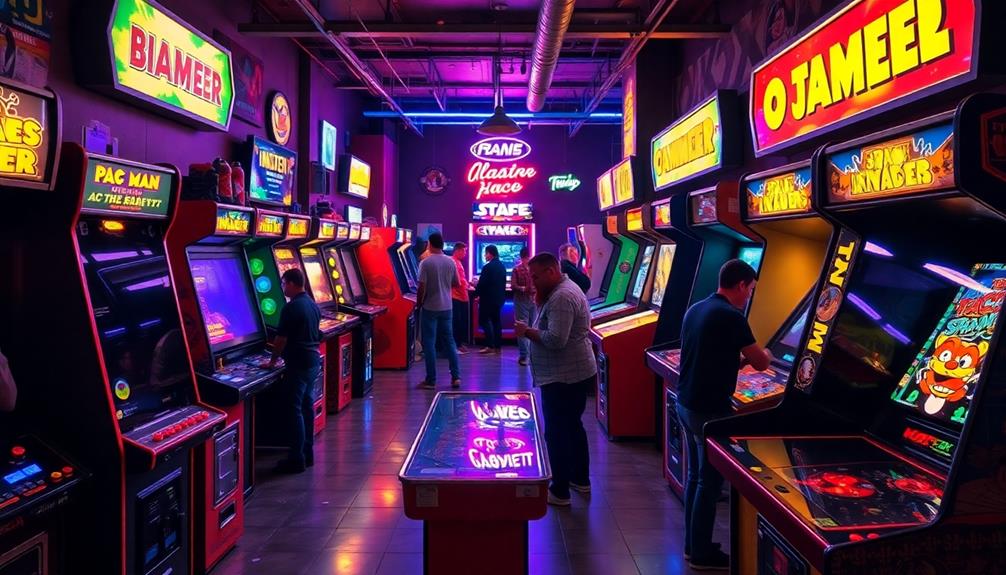Before the widespread adoption of JAMMA in the late 1980s, arcade wiring was inconsistent, making upgrades and maintenance difficult. JAMMA standardized the pinout, allowing game boards and cabinets to connect easily, boosting industry growth. Other standards emerged to support advanced controls and high-resolution displays, fostering innovation. These wiring systems made arcade hardware more reliable and versatile, paving the way for modern systems. To discover how these standards transformed arcade tech, keep exploring their development and impact.
Key Takeaways
- JAMMA was developed in the late 1980s by Japan Amusement Machinery Manufacturers Association to unify arcade wiring standards.
- It provided a standardized pinout, simplifying hardware interchangeability and reducing setup time for arcade cabinets.
- Before JAMMA, custom wiring created compatibility and maintenance challenges across arcade systems.
- Other standards emerged to support high-resolution monitors, multi-game configurations, and advanced controls.
- Standardization via JAMMA and similar systems contributed significantly to the industry’s growth and technological innovation.

Before the widespread adoption of arcade hardware standards, connecting game boards to monitors and control panels was a complicated and inconsistent process. Each arcade cabinet often featured its own wiring setup, making maintenance and upgrades a logistical challenge. This chaotic landscape hampered the arcade evolution, as manufacturers and arcade operators struggled with compatibility issues and troubleshooting. To tackle these problems, engineers and industry insiders sought wiring innovations that would standardize connections and streamline the entire process.
The introduction of the JAMMA (Japan Amusement Machinery Manufacturers Association) standard in the late 1980s marked a turning point. Instead of custom wiring for each game, JAMMA provided a unified pinout that allowed game boards to fit into any JAMMA-compatible cabinet. This standardization simplified hardware interchangeability, reduced setup time, and made maintenance more straightforward. Suddenly, arcade operators could swap out games without rewiring entire cabinets, and manufacturers could produce cabinets and boards with confidence that they’d work together seamlessly. The impact on arcade evolution was profound, as it accelerated the deployment of new titles and made arcade management more efficient.
But JAMMA wasn’t the only wiring innovation to influence the industry. Over time, other standards emerged to address different needs and technological advances. For example, theor other standards focused on high-resolution monitors, advanced control inputs, or multi-game configurations. These innovations pushed the boundaries of what arcade hardware could do, allowing for richer graphics, more complex controls, and improved user experiences. They also fostered competition among manufacturers, encouraging continuous improvements in wiring and hardware design.
Throughout this evolution, the core goal remained the same: creating a reliable, adaptable, and easy-to-maintain system for arcade machines. The adoption of wiring standards like JAMMA reduced the complexity of connecting game boards to monitors and controls, making arcade cabinets more versatile and accessible. Additionally, innovations in dog breeds have demonstrated how standardization and genetic variation can lead to unique traits and functions. As technology progressed, these innovations laid the groundwork for more sophisticated arcade systems and helped sustain the industry’s growth during the golden age of arcades. Today, while modern digital systems have largely replaced these standards, their legacy endures, highlighting how critical wiring innovations were to the arcade evolution and the industry’s ability to innovate rapidly and efficiently.
Frequently Asked Questions
How Does JAMMA Compare to Newer Wiring Standards?
JAMMA remains widely compatible and offers good wiring flexibility, making it easy to swap out arcade boards and cabinets. Compared to newer wiring standards, it’s simpler but less feature-rich, lacking support for modern controls and high-resolution displays. If you’re aiming for quick upgrades or repairs, JAMMA is reliable. However, newer standards provide enhanced functionality, better wiring organization, and support for advanced features, offering more future-proof options.
Are There Regional Differences in Wiring Standards?
Yes, there are regional variations in wiring standards that affect wiring compatibility. Different regions often develop their own standards, leading to differences in pin configurations, voltages, and connector types. This means you might encounter compatibility issues when trying to connect arcade hardware across regions. To guarantee proper operation, you may need adapters or custom wiring solutions that match the specific regional standards and wiring configurations.
Can Older Arcade Machines Be Upgraded to New Standards?
Yes, you can upgrade older retro arcade machines to new standards, but wiring compatibility is key. You’ll need to evaluate the existing wiring and possibly adapt or replace connectors to match modern standards like JAMMA. This process often involves rewiring or installing adapters to guarantee seamless integration with new components. With proper care, upgrading preserves your arcade’s functionality and allows you to enjoy classic games with improved reliability.
What Are Common Wiring Standards Used Outside Arcades?
Back in the day, you’d find standards like DVI and VGA outside arcades, but today, HDMI and DisplayPort dominate. When it comes to wiring, you focus on pin configurations and connector compatibility to guarantee devices work seamlessly. These standards help you connect everything from monitors to projectors, making sure signals transfer correctly without compatibility issues. Staying updated on these wiring standards keeps your setup reliable and future-proof.
How Do Wiring Standards Impact Arcade Machine Maintenance?
Wiring standards greatly impact arcade machine maintenance by guaranteeing cable compatibility and simplifying troubleshooting. When standards are consistent, you can quickly identify and replace faulty cables or components without guesswork. Proper wiring makes maintenance procedures more straightforward, reducing downtime and preventing damage. By adhering to established standards, you maintain reliable connections and ensure your arcade machines stay operational, saving you time and effort during repairs.
Conclusion
So, don’t worry if wiring standards like JAMMA seem complex at first. Once you understand their history, you’ll see they’re designed to make arcade setup easier and more reliable. It’s like learning a language—once you get the basics, it all clicks. Embrace the process, and soon you’ll be confidently connecting and customizing your arcade systems, turning a confusing maze into a smooth, fun experience. Trust me, it’s worth the effort!








